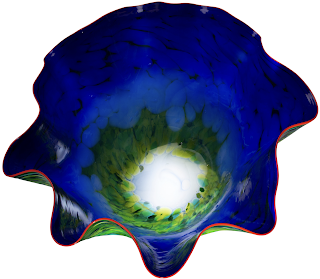Monumental Cobalt Macchia with Huckleberry Lip Wrap, 2012; Free blown, flared form with undulating rim, dappled with shades of green and yellow with a cobalt blue interior and huckleberry lip wrap; Engraved Chihuly 12; Provenance: Estate of Richard L. Weisman, Beverly Hills, CA; Size: 19 1/2 x 35 x 33 1/2".
"My
work, to this day revolves around a simple set of circumstances: fire,
molten glass, human breath, spontaneity, centrifugal force, gravity." -
Dale Chihuly
Dale Chihuly was born on September 20, 1941 and is an American glass
sculptor. His works are considered to be exceptional in the field of
blown glass; and he has adapted the technical difficulties of the medium
to explore and implement installations, as well as environment specific
artwork.
Chihuly
first began experimenting with glass blowing in 1965 and began an
extensive education centered around sculpture. He earned a Master of
Fine Arts degree in sculpture from the Rhode Island School of Design in
1968; and that same year was awarded a Louis Comfort Tiffany Foundation
grant for his work in glass, as well as a Fulbright Fellowship. He
traveled to Venice to work at the Venini factory on the island of
Murano, where he first saw the team approach to glass blowing. In 1976,
while in England, he was involved in a head-on-car crash which propelled
him through the windshield. His face was severely cut by glass and he
was permanently blinded in his left eye. After recovering, he continued
to blow glass until he dislocated his right shoulder in 1979 while body
surfing.
No
longer able to hold a glassblowing pipe, he was able to utilize the
team approach to glass blowing he had seen in Murano, and hired other
artists to do the physical work. Chihuly explained the change saying,
"Once I stepped back, I liked the view." He felt liberated and more free
to see the work from multiple perspectives, and the change enabled him
to anticipate problems earlier and to react. His role in the studio
changed from participate, to supervisor and problem solver. One of the
most critically acclaimed series by Chihuly was the Macchia series.
Macchia, which is Italian for spot, was begun in 1981 and continues
today.
As Chihuly has explained:
"The Macchia
series began with my waking up one day wanting to use all three hundred
of the colors in the hot shop. I started by making up a color chart
with one color for the interior, another color for the exterior, and
contrasting color for the lip wrap, along with various jimmies and dusts
of pigment between the layers of glass. Throughout the blowing process,
colors were added, layer upon layer. Each piece was another experiment.
When we unloaded the ovens in the morning, there was the rush of seeing
something I had never seen before. Like much of my work, the series
inspired itself. The unbelievable combination of color - that was the
driving force."
From Timothy Anglin Burgard, Chihuly the Artist: Breathing Live into Glass, 2008:
(The Macchia)
Often balanced slightly off-center, they attempt to capture the essence
of glass in its most volatile sate - simultaneously hot and flowing,
but also cool and congealing. The blurred edges of the color striations
and "spots" suggest that they are being dissolved by heat or have
coalesced into opal-like mineral deposits. Chihuly's "lip wraps," think
ribbons of colored glass that run along the vessel's lip suggest the
presence of a super-heated inner core and recall the leading edge of a
lava flow, breaking through the congealing perimeter of a magma mass. -
Chihuly's Macchia are permanently aglow with the fires of their
creation."
The following are various views of Cobalt Macchia with Huckleberry Lip Wrap, 2012 by Dale Chihuly:
From Robert Hobbs, The Rhoda Thalhimer Endowed Professor of American Art History, Virgina Commonwealth University:
"In the Macchia,
Chihuly makes this former (Classic Venetian blown glass) static
orientation dynamic and enlarges this conservative scale to awesome
proportions. He heightens tensions between inside and outside through
dissonant color combinations and through contrasts of opacity,
translucency, and transparency. Rather than continuing the preciousness
of the filigree of the Bianconi examples, he creates a bolder impact by
rolling ships of colored glass into the walls of the vessel for a
mottled effect."
Chihuly and his team of artists have been the subjects of several documentaries, extensive printed articles, monographs, and collections. For a complete list of Museum collections, please click on the link below:
Engraved Chihuly signature and 2012 date.
"Cobalt Macchia with Huckleberry Lip Wrap," 2012 is an exceptional example of Dale Chihuly at his best. This monumental Macchia is composed of cobalt blue as the dominant interior color, green and yellow spots are set against the blue interior ground, and finished with a contrasting huckleberry colored lip. An absolutely stunning and massive piece of modern glass by the most important glass artist of his time, and a standout of any art collection!














